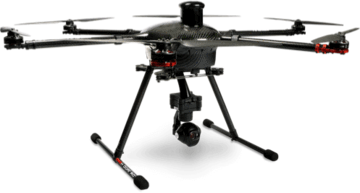Enterprise Mobility & the Connected Worker Blog
The Impact of 5G on Unmanned Aerial Systems in Ports Operations
by Rowan Litter | 09/02/2020
Maritime trade accounts for 90% of overall global trade. By far the most cost-effective way to move goods, this method of trade is essential to the world economy. Once vessels arrive at their destination, they must anchor and wait to be called into port, which can sometimes take over a month. After finally being called in, vessels must navigate through narrow and crowded harbors to have their cargo unloaded/reloaded before heading back to sea. Port authority agencies operate and manage ports to ensure the safe navigation of vessels, run maritime search and rescue operations, handle cargo movements, enforce environmental and The International Convention for the Prevention of Pollution from Ships (“MARPOL”) regulations and provide surveillance and security for port areas. All of these operations are limited by stationary cameras, vessel traffic management systems, and other current port technology capabilities. Implementing Unmanned Aerial Systems in port operations provides authorities with greater visibility, safety, and a wide range of enhanced functionalities. A number of ports across the world have already implemented drones into their day-to-day operations and with the introduction of 5G technology, the value of drones in port operations may increase even further.
 Drones that are implemented into port operations are being used for a variety of functions. UASs, controlled by on-the-ground operators through a mobile device or in a control room, provide surveillance points that are not possible with traditional surveillance systems. However, when UASs are combined with stationary camera infrastructure and facial recognition software, operators get an ultimate view of the area. Drones also enforce compliance and environmental regulations, as authorities use drones with sensors and high-resolution cameras to detect and report MARPOL violations by vessels, as well as scanning waters for illegal fishing and activities. The delivery of essential supplies to waiting and anchored vessels was traditionally done by smaller watercrafts, but drones have proven faster and a more environmentally-friendly alternative. A new low-sulfur fuel mandate was put into effect on January, 2020, and authorities are using drones to fly through smoke plumes of ships and analyze the amount of sulfur contained in the fuel. There are also cases for drones to improve inventory (cargo) management and worker accident prevention. Inspections that formerly could not be conducted, such as on the ends of “port-cranes,” can be easily and frequently done via drones.
Drones that are implemented into port operations are being used for a variety of functions. UASs, controlled by on-the-ground operators through a mobile device or in a control room, provide surveillance points that are not possible with traditional surveillance systems. However, when UASs are combined with stationary camera infrastructure and facial recognition software, operators get an ultimate view of the area. Drones also enforce compliance and environmental regulations, as authorities use drones with sensors and high-resolution cameras to detect and report MARPOL violations by vessels, as well as scanning waters for illegal fishing and activities. The delivery of essential supplies to waiting and anchored vessels was traditionally done by smaller watercrafts, but drones have proven faster and a more environmentally-friendly alternative. A new low-sulfur fuel mandate was put into effect on January, 2020, and authorities are using drones to fly through smoke plumes of ships and analyze the amount of sulfur contained in the fuel. There are also cases for drones to improve inventory (cargo) management and worker accident prevention. Inspections that formerly could not be conducted, such as on the ends of “port-cranes,” can be easily and frequently done via drones.
In April, the Maritime Port Authority of Singapore (MPA) announced it is partnering with Infocomm Media Development Authority (IMDA), M1 Limited (M1), and Airbus to administer 5G standalone network trials at Singapore’s Maritime Drone Estate (SMDE), an area specific to drone testing developments and applications. The goal of these trials is to establish an open and inclusive 5G ecosystem, in which drones can increase efficiencies in port operations, and managing and responding to incidents. 5G technologies can provide enhanced geo-location and communication functions for unmanned aerial systems using network-based information. Due to 5G’s lower latency, higher capacity and increased bandwidth capabilities, drone location information is more precise than GNSS location technologies. With 5G connectivity, drones can also handle more intensive computing processes, such as IoT solutions that provide better ground-to-air communication services, control commands and telemetry data. How will 5G be integrated into UASs? TeamOne is developing World’s first aeronautical certified 5G standalone communication modem for Urban Air Mobility operations. The trials at SMDE will test the 5G modem design and help form a better understanding of 5G standards, feasibility and requirements for UAM applications. The implications of these trials will provide the standard for future 5G use in UAV designs and operations. In early April, Germany’s Unmanned Air Traffic Management (UTM) service provider, Droniq, introduced a modem device that can be hooked to a drone, enabling the drone to connect to a mobile network and communicate its precise location to the UTM system.
By implementing mobile network communications in drones for port operations, port authorities will be able to collect more accurate information faster, and can focus more on management and response as opposed to surveillance. Mobile network connections will help operators better navigate and manage vessel traffic. More precise geo-location and faster information-sharing can increase the effectiveness of search and rescue operations, potentially saving more lives. As anchored vessels wait to be called into port, they receive essential supplies from port authorities; drones have emerged as a great alternative solution for these deliveries, and with 5G capabilities, operators can better track drones, optimize routes and communicate with vessels. Global trade activity will continue to increase along with demand for faster transportation and delivery, enabling network-enabled drones to be deployed in more port areas around the world.
View the 2020 Enterprise Mobility and the Connected Worker Research Outline to learn more